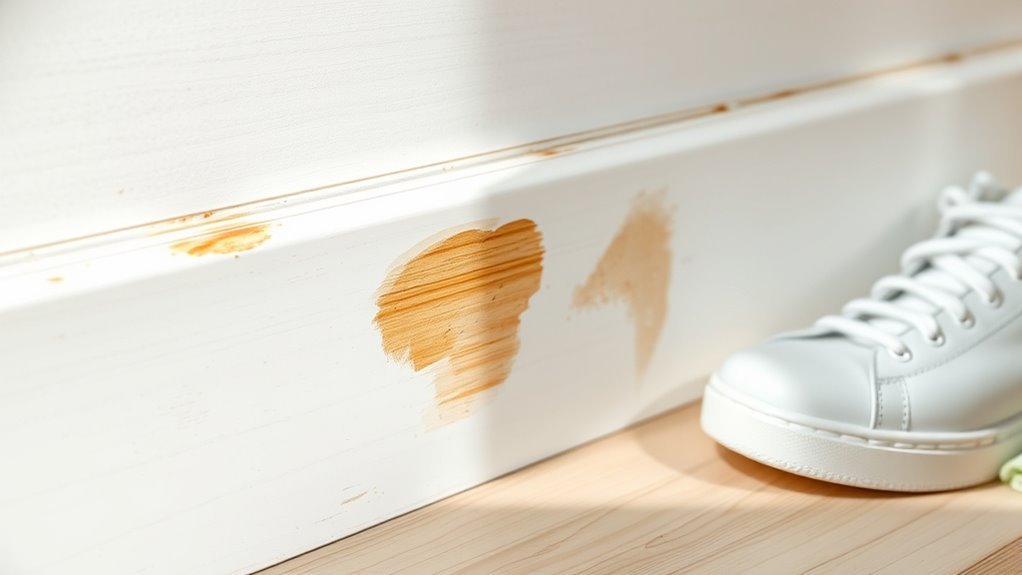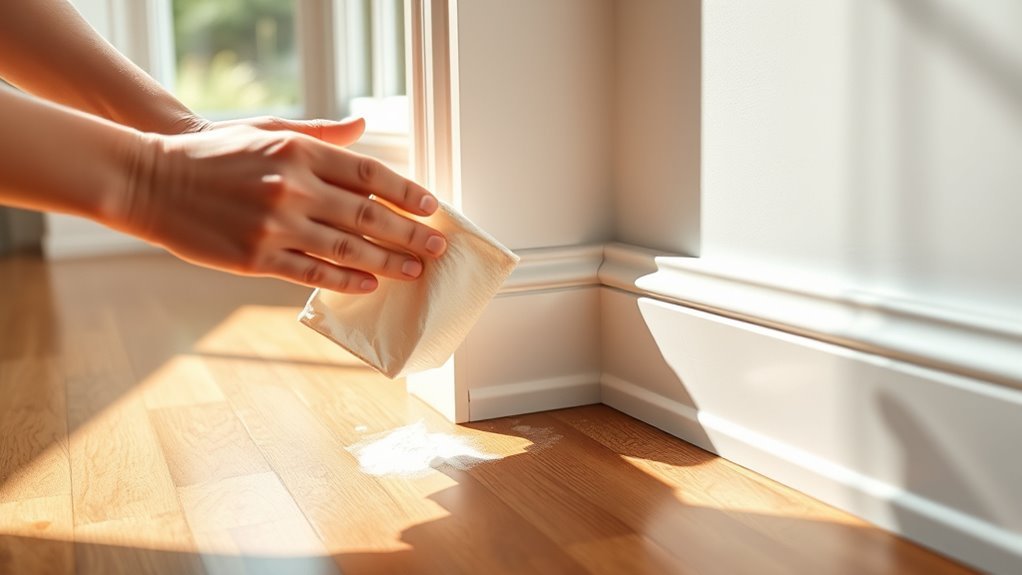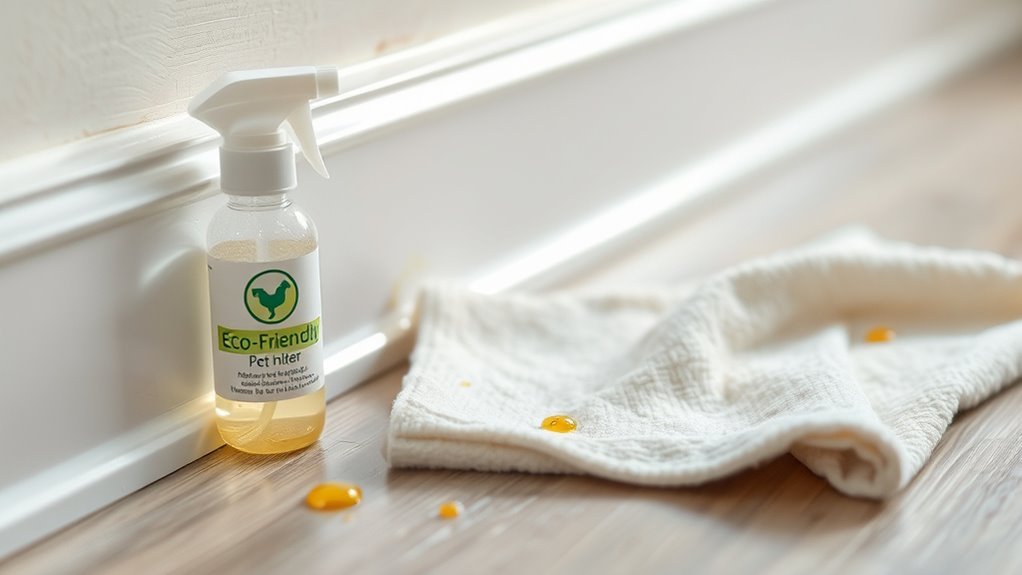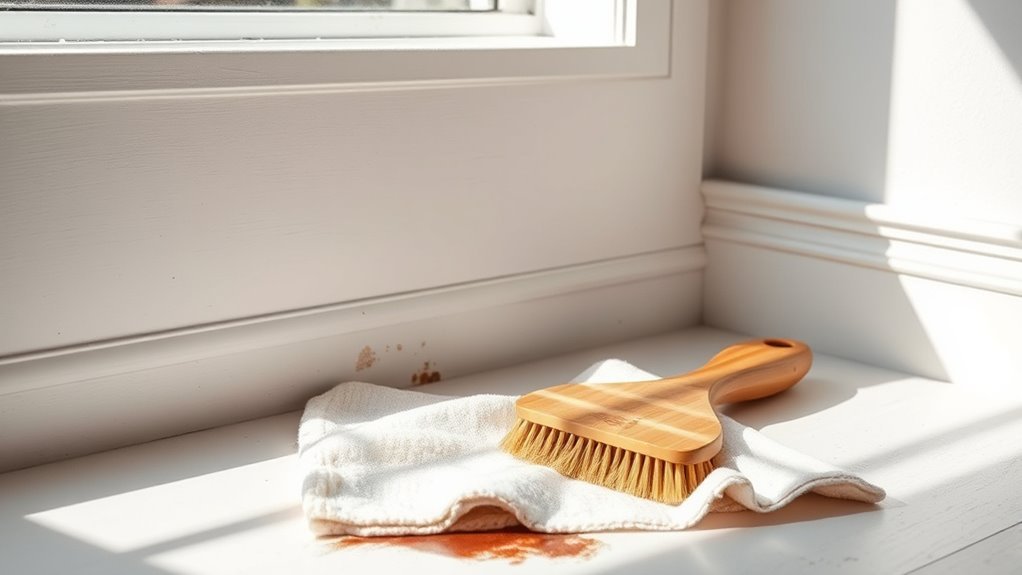How to Remove Stubborn Stains From Baseboards
To remove stubborn baseboard stains, start by identifying the stain type so you can choose the right method. Use a soft cloth and mild soap mixed with warm water for most stains, avoiding harsh chemicals. For scuff marks, a magic eraser works wonders, while enzymatic cleaners tackle pet stains effectively. Always prep the area by dusting first and rinse well after cleaning to prevent residue. Keep going to discover more tips for maintaining spotless baseboards.
Identifying Different Types of Stains on Baseboards

Before you can tackle stubborn stains on your baseboards, it’s important to identify what kind of stain you’re dealing with. Stain identification is the first step toward effective cleaning and maintaining your freedom from endless scrubbing. You’ll come across various stain types like dirt smudges, scuff marks, grease spots, or even paint drips. Each demands a different approach, so knowing exactly what you’re facing saves you time and effort. For instance, dirt is usually dry and powdery, while grease feels sticky and dark. Scuff marks often come from shoes and have a different texture or color. By recognizing these stain types early on, you empower yourself to choose the right cleaning method and reclaim your baseboards without frustration.
Essential Cleaning Tools and Materials
Getting your baseboards spotless starts with having the right tools and materials on hand. You’ll want to gather essential tools and effective cleaning products that make tackling stubborn stains easier and quicker. Here’s a quick guide to what you’ll need:
| Tool | Purpose | Recommended Product |
|---|---|---|
| Soft Cloth or Sponge | Gentle scrubbing | Microfiber cloth |
| Small Brush | Detail cleaning in grooves | Old toothbrush |
| Cleaning Solution | Stain removal | Mild detergent or vinegar mix |
Choosing the right tools frees you from frustration and delivers results without damaging your baseboards. With these essentials ready, you’re prepared to conquer any stain and enjoy the freedom of a fresh, clean home.
Preparing Your Baseboards for Cleaning

While it might be tempting to dive straight into scrubbing, you’ll want to prepare your baseboards properly to secure the best results. Start by checking your cleaning schedule—if it’s been a while, a quick dusting or vacuuming will remove loose dirt and prevent scratching. Next, identify the baseboard materials; wood, MDF, and vinyl each need different care. For wood, avoid excess water to protect the finish, while vinyl can handle a bit more moisture. Inspect for any damage like chips or cracks that could worsen during cleaning. Clearing the area around your baseboards, like moving furniture or rugs, gives you full access and freedom to work efficiently. Taking these steps guarantees your cleaning efforts go smoothly and your baseboards stay in great shape.
Using Mild Soap and Water for Light Stains
When tackling light stains on your baseboards, start by picking a mild soap that won’t damage the paint or finish. Mix a small amount with warm water to create a gentle cleaning solution. Then, use a soft cloth or sponge to carefully wipe away the stains without scrubbing too hard.
Choosing the Right Soap
Choosing the right soap is key to tackling light stains without damaging your baseboards. When selecting soap types, you want something gentle yet effective. Mild dish soap or castile soap are great options—they clean well without harsh chemicals that might strip paint or finish. Avoid abrasive or heavily scented soaps, as these can leave residue or cause discoloration over time. Soap effectiveness comes down to balancing cleaning power with gentleness; too strong, and you risk damage; too weak, and stains won’t budge. Remember, your goal is freedom from stains without sacrificing your baseboards’ look or integrity. By choosing a mild soap that’s proven effective, you maintain control over the process and protect your home while enjoying a cleaner, fresher space.
Preparing the Cleaning Solution
To prepare an effective cleaning solution for light stains, you’ll need just two simple ingredients: mild soap and warm water. This combo is your go-to alternative cleaning solution, offering a gentle yet effective way to refresh your baseboards without harsh chemicals. Start by filling a bucket with warm water, then add a few drops of mild soap—something eco friendly, like castile soap or a biodegradable dish detergent. Mix it gently to avoid too many suds. Using this solution lets you clean freely, knowing you’re minimizing your environmental impact while still tackling dirt and grime. It’s a smart, simple step toward maintaining a clean space without compromising your values or the health of your home.
Effective Gentle Cleaning Methods
Although mild soap and warm water may seem simple, they’re surprisingly effective at removing light stains from your baseboards without causing damage. By using gentle scrubbing techniques, you can free your baseboards from grime while preserving their finish. Start by dipping a soft cloth or sponge into your eco friendly cleaners—mild soap mixed with water works perfectly. Then, focus on:
- Soft, circular motions to lift dirt without scratching
- Targeting corners and edges where dust settles
- Rinsing frequently to avoid spreading stains
This method lets you maintain fresh, clean baseboards effortlessly. Plus, by choosing eco friendly cleaners, you protect your home and the environment. Embrace this simple, gentle approach and reclaim your space with ease and care.
Tackling Scuff Marks With Magic Erasers
When scuff marks stubbornly cling to your baseboards, magic erasers can be a game-changer. These handy tools work by gently lifting away marks without harsh chemicals, giving you freedom from scrubbing endlessly. Start by dampening the magic eraser and lightly rubbing the scuff mark in a circular motion. Use gentle pressure to avoid damaging paint or finish—magic eraser techniques rely on friction, not force. After cleaning, wipe the area with a damp cloth to remove any residue. To keep your baseboards looking fresh longer, practice scuff mark prevention by placing furniture pads and encouraging mindful movement around your space. With these simple steps, you’ll regain clean, crisp baseboards and enjoy the open, unburdened feeling that comes with a neat home.
Removing Pet Stains and Odors Effectively

When dealing with pet stains on your baseboards, it’s important to first identify the type of stain you’re facing. You’ll also want to use natural odor neutralizers to keep your home smelling fresh without harsh chemicals. Finally, choosing the right cleaning solution designed for pet stains will help you tackle both the mark and the smell effectively.
Identifying Pet Stain Types
How can you tell what kind of pet stain you’re dealing with? Recognizing the type helps you tackle it effectively and reclaim your space. Look closely for these clues:
- Pet urine: Usually a yellowish stain with a strong ammonia-like smell, often near baseboards or corners where pets mark territory.
- Pet feces: Darker, solid residues that might leave a lingering odor and occasionally smudge marks on your baseboards.
- Pet vomit: Often a mix of semi-solid matter and hair clumps, with a sour, unpleasant smell.
Don’t forget pet hair around the stain—it’s a sign your furry friend was nearby. Identifying these types sets you free to choose the right cleaning method without guesswork.
Natural Odor Neutralizers
A great way to tackle pet stains and odors without harsh chemicals is by using natural odor neutralizers. Start by sprinkling baking soda directly onto the stained baseboards—it absorbs odors and loosens grime. After letting it sit for 15 minutes, wipe away with a cloth dampened in a vinegar solution (equal parts vinegar and water). This combo breaks down stains while neutralizing smells naturally. For an extra clean touch, add a few drops of essential oils like lavender or eucalyptus to the vinegar mixture. Citrus cleaners are another excellent option; their natural acids cut through residue and leave a revitalizing scent. Using these natural methods keeps your baseboards clean and your home smelling fresh, all without compromising your freedom from harsh chemicals.
Cleaning Solutions for Pets
Natural odor neutralizers can handle mild pet stains, but tougher messes often need stronger cleaning solutions. When dealing with pet stains on your baseboards, choose pet safe cleaners that tackle odors and grime without harmful chemicals. This helps keep your home fresh while protecting your furry friends. For effective stain prevention, act quickly and use targeted products designed for pet messes.
Here’s what you can do:
- Blot spills immediately to prevent stains from setting in.
- Use enzymatic cleaners that break down organic stains and odors.
- Regularly wipe down baseboards to catch dirt before it builds up.
With the right approach, your baseboards stay clean, and you keep your freedom to enjoy your pets without worry.
Dealing With Tough Dirt and Grime Buildup
When dirt and grime have settled deep into your baseboards, simple wiping won’t cut it. You need effective dirt removal techniques that break through layers of buildup without damaging the surface. Start by mixing warm water with a few drops of dish soap or a gentle cleaner. Use a soft-bristled brush or an old toothbrush to scrub stubborn spots, getting into crevices where grime hides. For tougher buildup, a paste of baking soda and water can work wonders—apply, let it sit, then scrub gently. Rinse with a damp cloth to avoid residue. Keep in mind, consistent grime prevention strategies—like regular quick cleans—help reduce tough buildup over time. Tackling grime head-on gives you the freedom to enjoy spotless, fresh baseboards effortlessly.
Preventative Tips to Keep Baseboards Stain-Free
Although stubborn stains can be tough to remove, you can greatly reduce their occurrence by adopting simple preventative habits. Taking charge of your baseboard maintenance means embracing easy preventative measures that keep your space looking fresh and free. Start by:
Prevent stubborn stains by adopting easy, effective preventative habits for fresh, clean baseboards.
- Wiping down baseboards weekly with a damp cloth to prevent dust and dirt buildup.
- Using door stoppers or guards to avoid scuffs and marks from furniture or shoes.
- Applying a protective sealant to wooden baseboards to repel grime and moisture.
Frequently Asked Questions
Can I Use Bleach on Painted Baseboards?
Imagine your baseboards as a canvas, delicate and full of character. You can use bleach, but with caution—bleach safety is essential because it can strip or discolor painted surfaces. If you decide to use it, dilute it well and test on a hidden spot first. Always wear gloves and guarantee good ventilation. This way, you protect your freedom to keep your home fresh without damaging your beautiful painted baseboards.
How Often Should Baseboards Be Cleaned?
You’ll want to set a baseboard cleaning frequency that fits your lifestyle and keeps your space feeling fresh. Generally, cleaning them every 1 to 3 months works well as part of your maintenance schedule, but if you have pets or kids, you might want to do it more often. Sticking to a routine helps prevent tough grime buildup, so you’re not stuck scrubbing for hours later—keeping your freedom intact and your home looking sharp.
Are There Eco-Friendly Stain Removers for Baseboards?
Yes, you can totally go green with eco-friendly stain removers for your baseboards. Natural cleaning solutions like vinegar, baking soda, and lemon juice work wonders without harsh chemicals. You might even whip up DIY stain removers using these simple ingredients, giving you freedom from toxic products while keeping your home fresh and clean. Plus, they’re gentle on surfaces and safe for your family. Give it a try—you’ll love the results!
Can Baseboards Be Repainted After Stain Removal?
Wondering if you can refresh your baseboards with a new coat after tackling those tough stains? Absolutely, you can! Repainting techniques like sanding and priming help the paint stick better, giving your baseboards a smooth finish. When picking paint types, consider semi-gloss or satin finishes—they’re durable and easy to clean. So go ahead, release your creativity and give your baseboards the freedom to shine anew!
What Should I Do if the Stain Damages the Baseboard?
If the stain’s caused damage, you’ll want to focus on baseboard repair to restore its look. First, sand down any rough or damaged spots, then fill cracks or holes with wood filler. Once dry, sand smooth and repaint. To avoid future headaches, follow stain prevention tips like wiping spills quickly and using protective coatings. This way, you keep your baseboards looking fresh without feeling trapped by constant maintenance.






